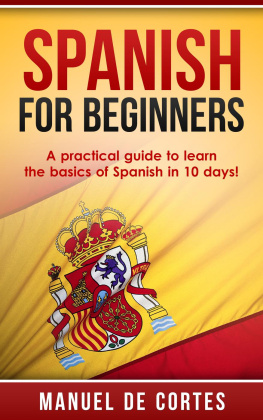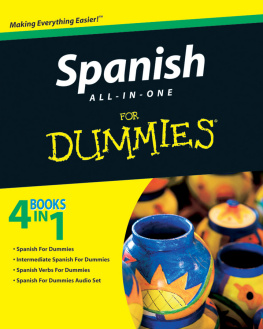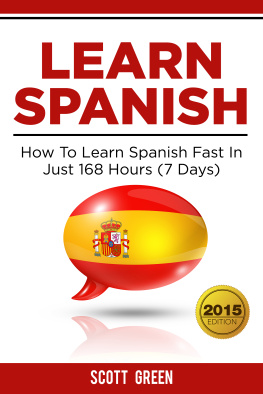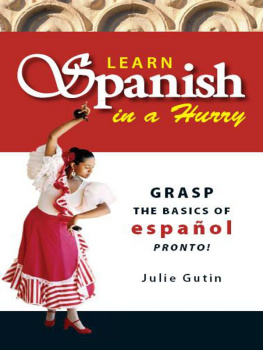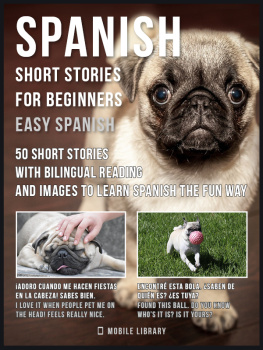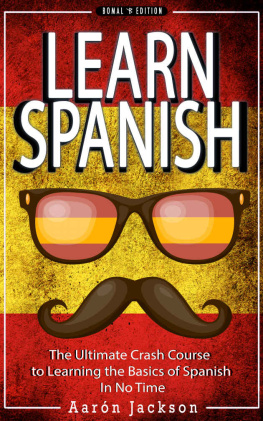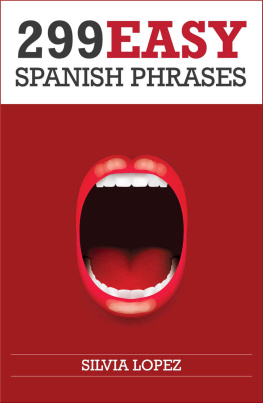SPANISH FOR BEGINNERS
A Practical Guide To Learn The Basics of Spanish
in 10 Days
MANUEL DE CORTES
SPANISH FOR BEGINNERS
Copyright 2015 by Manuel De Cortes.
All rights reserved.
This document is geared towards providing exact and reliable information in regards to the topic and issue covered. The publication is sold with the idea that the publisher is not required to render accounting, officially permitted, or otherwise, qualified services. If advice is necessary, legal or professional, a practiced individual in the profession should be ordered.
From a Declaration of Principles which was accepted and approved equally by a Committee of the American Bar Association and a Committee of Publishers and Associations.
In no way is it legal to reproduce, duplicate, or transmit any part of this document in either electronic means or in printed format. Recording of this publication is strictly prohibited and any storage of this document is not allowed unless with written permission from the publisher. All rights reserved.
The information provided herein is stated to be truthful and consistent, in that any liability, in terms of inattention or otherwise, by any usage or abuse of any policies, processes, or directions contained within is the solitary and utter responsibility of the recipient reader. Under no circumstances will any legal responsibility or blame be held against the publisher for any reparation, damages, or monetary loss due to the information herein, either directly or indirectly.
Respective authors own all copyrights not held by the publisher.
The information herein is offered for informational purposes solely, and is universal as so. The presentation of the information is without contract or any type of guarantee assurance.
The trademarks that are used are without any consent, and the publication of the trademark is without permission or backing by the trademark owner. All trademarks and brands within this book are for clarifying purposes only and are the owned by the owners themselves, not affiliated with this document.
Table of Contents
Preview of: Italian for Beginners
Check Out My Other Books
D ear reader,
I firstly want to express my thanks to you for buying and downloading the book Spanish For Beginners: A pratical guide to learn the basics of Spanish in 10 days! .
I also want to tell you that youre awesome for wanting to learn this beautiful and extraordinary language. This book contains proven steps and strategies on how to communicate using the basics of the Spanish language.
Divided into 10 chapters (one chapter per day), this book is designed to provide a step by step learning guide on Spanish grammar, vocabulary, and pronunciation. Plus, it features a series of useful common everyday expressions.
This book is written in a conversational style thats easy to follow and understand. After reading this book, youll never have to say No hablo Espaol ever again!
Thanks again for purchasing this book,
I hope you enjoy it!
Manuel De Cortes
Chapter 1:
The Spanish Alphabet
(El Alfabeto Espaol)
S panish is one of the most frequently spoken languages of today. It is also one of the easiest ones to learn for English-speaking people since its alphabet is very similar to the alphabets of other European languages.
In order to learn to speak Spanish, youll have to be familiar with all the letters in the Spanish Alphabet and pronounce them all properly. Remember, letters are the building blocks for words. Each phoneme (sound represented by a symbol) should be uttered correctly in order to achieve proper pronunciation of words.
The Spanish Alphabet is composed of 30 letters. All of them are similar to the letters in the English alphabet (which contains 26 letters) plus it includes four more, namely: ch (che), ll (elle), rr (erre), and of course the famed (enye).
There may be a few regional variations and such letters as c and ch may sometimes be considered as one letter. But the list of letters in the Spanish Alphabet below consist of what is most commonly taught to Spanish learners and is based on the standard Castilian Spanish.
A : a
B: be (or grande be)
C: ce
Ch: che
D: de
E: e
F: efe
G: ge
H: hache
I: i
J: jota
K: ka
L: ele
Ll: elle
M: eme
N: ene
: ee (pronounced enye)
O: o
P: pe
Q: cu
R: ere
Rr: erre
S: ese
T: te
U: u
V: uve (also called ve or chica ve)
W: uve doble (or doble ve)
X: equis
Y: y griega
Z: zeta (pronounced theta)
There have been also been disagreements on whether the letters W and K should be considered as parts of the alphabet. This is because these letters are only used for words of foreign origin. Nevertheless, its better to assume that they are included since it would make us more precise with our pronunciation guide.
H ave you ever noticed how some native Spanish speakers usually sound like theyre mumbling? This is because Spanish consonant sounds are usually softer and less distinct than their English counterparts (with the exception of r and rr ). Conversely, their vowels have more distinct sounds than their English equivalents.
Below is a guide to the proper pronunciation of vowels and consonants. Those not included are pronounced the same as their English counterparts.
- The letters B and V pose spelling problems in Spanish. They are pronounced EXACTLY THE SAME WAY. Thus the phrases grande be (big b) and chica ve (small v) in order to tell them apart. The thing is, the English sound v in victory does not exist in Spanish. B and V are usually pronounced somewhat similar to the English v with one distinctive difference. That is, it is made by making the lips touch each other instead of the upper teeth and lower lip. However, there are instances when B and V are pronounced like the English b. This happens when they are found in the beginning of a sentence or phrase.
Next page
